





-- Kythera Collection of Byzantine and Post-Byzantine Art --
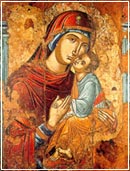 A large number of archaeological sites and monuments covering its cultural history from pre-historic, classical to Christian and modern times. Although only a few monuments and remains have survived from antiquity the opposite is true of Christian times. Churches, built in a remarkable variety of architectural types, monasteries, castles, fortified settlements, mosaics, wall paintings and other treasures all form a rich background that brings to life the island’s history and culture. Greece’s Department of Archaeology has collected and rescued the fragile paintings and frescoes from many abandoned churches. This collection is housed in the post-Byzantine church of the Analipsi (Ascension) in Kato Livadi. It comprises examples of the artistic styles from early Christian times until the late post-Byzantine period. The exhibition also includes fragments of a important early Christian floor mosaic from the ruined church of Agios Ioannis (Saint John) at Potamos. The project of displaying religious and archaeological treasures in the place from which they came represents a first step in the direction of presenting and promoting the rich, contribution of Kythera to the artistic history of Greece.
A large number of archaeological sites and monuments covering its cultural history from pre-historic, classical to Christian and modern times. Although only a few monuments and remains have survived from antiquity the opposite is true of Christian times. Churches, built in a remarkable variety of architectural types, monasteries, castles, fortified settlements, mosaics, wall paintings and other treasures all form a rich background that brings to life the island’s history and culture. Greece’s Department of Archaeology has collected and rescued the fragile paintings and frescoes from many abandoned churches. This collection is housed in the post-Byzantine church of the Analipsi (Ascension) in Kato Livadi. It comprises examples of the artistic styles from early Christian times until the late post-Byzantine period. The exhibition also includes fragments of a important early Christian floor mosaic from the ruined church of Agios Ioannis (Saint John) at Potamos. The project of displaying religious and archaeological treasures in the place from which they came represents a first step in the direction of presenting and promoting the rich, contribution of Kythera to the artistic history of Greece.
MUSEUM HOURS: The Museum is open 8.00 - 14.30 Monday to Friday. Tel 27360-31731
-- Archaeological Museum --
If you are at all interested in piecing together the history of Kythera, then the Archaeological Museum in Chora is worth a visit. Though the collection is small it clearly represents Kythera’s impressive timeline. Even though many significant ancient objects have been lost forever due to both greed and ignorance, it was with foresight that from 1935 a collection began. It was then that local high school teacher, Spiros Stathis, began to diligently collect ancient Kytherian artefacts. He later donated this collection to the people of Kythera and so the Museum was officially opened in 1963. The Museum has a comprehensive collection of coins that range from pre-Christian, Byzantium, Venetian and Ionian state coins. There is also a variety of Minoan objects found in the area of Paliopoli that date back to the 7th, 6th and 5th century BC. These objects include idols, amphoras, alabaster sculptures and ceramics. Of great interest is the marble lion. This lion was carved around 550BC while Kythera was under Spartan jurisdiction. It is unknown where it was first displayed but we know that in 1660 the Venetians placed the lion at the entrance to Chora’s Kastro. In 1941 while under German occupation the lion disappeared. It later resurfaced at an art auction in Belrin and was immediately recognized by a Kytherian who had grown up near the entrance of the Kastro. The lion was bought back by the Greek Government and returned to Chora in 1960. It is hoped that the lion will return to its original place once the Kastro is restored and that one day future generations will treasure and revere the Kastro as it once was. Also worth noting are various English gravestones from both the English occupation (1809 - 1864) and the sinking of the HMS Warspite and the HMS Gloucester in the strait between Kythera and Anti-Kythera.
MUSEUM HOURS: The Archaeological Museum is open 8.30 - 15.00 Tuesday to Saturday and 9.30 - 13.00 Sundays and closed on Mondays. Tel: 27360-31739
-- Agios Ioannis Theologos --
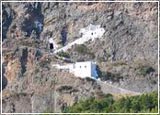 The chapel of Agios Ioannis Theologos is situated near the settlement of Kapsali, 2.5 km south of Kythera. The chapel was built in 1592, on a steep slope, thus it is called Agios Ioannis Gremon (: St John of the crevices). It was built in honour of the Evangelist John, as it is said that he lived here for a while, on his way to Patmos, writing part of the Apocalypses. The steep slope makes access to the church difficult, yet the view compensates for this. The pilgrims who come here on August 29th for the feast day of the church, usually stay in the preserved cells next to the church.
The chapel of Agios Ioannis Theologos is situated near the settlement of Kapsali, 2.5 km south of Kythera. The chapel was built in 1592, on a steep slope, thus it is called Agios Ioannis Gremon (: St John of the crevices). It was built in honour of the Evangelist John, as it is said that he lived here for a while, on his way to Patmos, writing part of the Apocalypses. The steep slope makes access to the church difficult, yet the view compensates for this. The pilgrims who come here on August 29th for the feast day of the church, usually stay in the preserved cells next to the church.
-- Agia Moni --
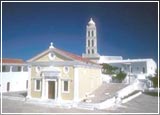 The monastery of Agia Moni (:Holy Monastery) is situated northwest of the village of Diakofti, 30 km away from Kythera. It was built in 1840 and dedicated to Our Lord the Saviour. Tradition claims that the monastery's holy icon was found in the bushes by a shepherd, in 1759. It is said that Theodoros Kolokotronis prayed here for a successful outcome to the Greek Revolution. To thank the Lord, he helped renovate the monastery in 1822. On August 6, the monastery's nameday, a multitude of pilgrims come here to pay their respects to the miraculous icon.
The monastery of Agia Moni (:Holy Monastery) is situated northwest of the village of Diakofti, 30 km away from Kythera. It was built in 1840 and dedicated to Our Lord the Saviour. Tradition claims that the monastery's holy icon was found in the bushes by a shepherd, in 1759. It is said that Theodoros Kolokotronis prayed here for a successful outcome to the Greek Revolution. To thank the Lord, he helped renovate the monastery in 1822. On August 6, the monastery's nameday, a multitude of pilgrims come here to pay their respects to the miraculous icon.
-- Monastery Myrtidion --
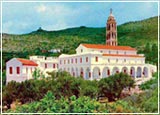 The monastery Myrtidion is situated near the village of Kalokerines, 12 km west of the island's capital. It is built among the myrtles, near the beach, overlooking the sea. According to tradition, the miraculous icon of Virgin Mary was found here by a shepherd, guided by a vision, in the 14th century. Although the shepherd took the icon to his home, the next day, the icon had disappeared only to be found again in the same place, a fact which was interpreted as Virgin Mary's wish for her icon to remain there. Originally, in this location, the people of the island built a small church which monk Leondios later extended by adding two new wings -the wings of St Theodoros and Zoodochos Pigi. The monastery, in its
The monastery Myrtidion is situated near the village of Kalokerines, 12 km west of the island's capital. It is built among the myrtles, near the beach, overlooking the sea. According to tradition, the miraculous icon of Virgin Mary was found here by a shepherd, guided by a vision, in the 14th century. Although the shepherd took the icon to his home, the next day, the icon had disappeared only to be found again in the same place, a fact which was interpreted as Virgin Mary's wish for her icon to remain there. Originally, in this location, the people of the island built a small church which monk Leondios later extended by adding two new wings -the wings of St Theodoros and Zoodochos Pigi. The monastery, in its 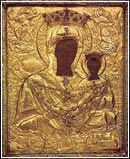 currently form, was founded in 19th century (1841-1857) by the Abbot Agathagelos Kalligeras.The church is small, built in the style of a three-nave basilica and it is quite similar to the church of Evagelistria, on the island of Tinos. In the church, one will admire the icons from the 17th and 18th century. The most valuable icon is the one of Virgin Mary, which has a gold carved exterior which, in 1837, replaced the previously silver one. Tradition says that the icon was constructed by the Evangelist Lucas whose model was Virgin Mary herself, and this is why the characteristics of the face are so vivid. Outside the church one will be impressed by the tall stone bell-toll, which was finished by Nikolaos Fatseas in 1888, as well as by the carefully preserved gardens. The church is crowded during the summer festival of August 15, as well as on September 24, when the icon was found.
currently form, was founded in 19th century (1841-1857) by the Abbot Agathagelos Kalligeras.The church is small, built in the style of a three-nave basilica and it is quite similar to the church of Evagelistria, on the island of Tinos. In the church, one will admire the icons from the 17th and 18th century. The most valuable icon is the one of Virgin Mary, which has a gold carved exterior which, in 1837, replaced the previously silver one. Tradition says that the icon was constructed by the Evangelist Lucas whose model was Virgin Mary herself, and this is why the characteristics of the face are so vivid. Outside the church one will be impressed by the tall stone bell-toll, which was finished by Nikolaos Fatseas in 1888, as well as by the carefully preserved gardens. The church is crowded during the summer festival of August 15, as well as on September 24, when the icon was found.
-- The cave of Agia Sofia --
 The cave of Agia Sofia is situated in a steep rock 60 m. high, outside Milopotamos, 15 km, northwest of Kythera. It is one of the most beautiful Greek caves. It was named after the chapel of Agia Sofia, which stands at the cave's entrance. The chapel was built in 1785 in honour of Agia Sofia, whose corpse is said to have been found here. The cave's interior is separated into numerous chambers. In the chamber where the chapel is one can admire a small lake with beautifully coloured water. The walls are covered with lovely stalactites and stalagmites of several sizes, as well as amazing murals from the 11th and 12th centuries. The chambers have names which refer to the colour and shape of the stalactites, such as "Venus's Chambers and Bathroom". There are also the Chambers of Ambers, of Pearls, of Bats, of Pine trees and of Leo.
The cave of Agia Sofia is situated in a steep rock 60 m. high, outside Milopotamos, 15 km, northwest of Kythera. It is one of the most beautiful Greek caves. It was named after the chapel of Agia Sofia, which stands at the cave's entrance. The chapel was built in 1785 in honour of Agia Sofia, whose corpse is said to have been found here. The cave's interior is separated into numerous chambers. In the chamber where the chapel is one can admire a small lake with beautifully coloured water. The walls are covered with lovely stalactites and stalagmites of several sizes, as well as amazing murals from the 11th and 12th centuries. The chambers have names which refer to the colour and shape of the stalactites, such as "Venus's Chambers and Bathroom". There are also the Chambers of Ambers, of Pearls, of Bats, of Pine trees and of Leo.
-- Castle of Avlemonas --
In the village of Avlemonas, 32 km northeast of Hora, one can admire parts of an old rectangular Venetian castle, built in 1565. On the castle's walls, one will admire the carved blazon of the Lion of Agios Markos. Also of note are the Venetian canons, which are still standing.
-- Castle of Milopotamos --
The Castle of Milopotamos is not only of the most significant sight-seeings in the area, but in the whole island, as well. It was built by the Venetians, in 1565 AD, after the destruction of the old capital -Palaiohora- by the pirate Barbarossa, in 1537. Above the central gate, the blazon of the "Lion of St Marcus and the Venetians", is beautiful carved. The Castle housed the residencies of the rich and the powerful families, store houses and laboratories for producing aliments. Today, here stand the ruins of the old houses and part of the castle's walls. From the Castle's single-nave marble temples with the beautiful painted walls, the only ones still existing are the churches of Agios Athantasios, Agios Ioannis Hrissostomos and Agios Cosmas. From Milopotamos' Castle on can distinguish the ruins of the School built during the English Occupation, by Mackvel, in 1825.
-- Castle of Hora --
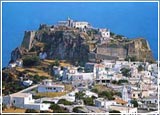 The Castle of Hora in Kythera is a typical example of a western fortification, and it still stands in very food condition. The Castle's construction began in 1316 from the Venetian Venteri family, upon the ruins of an old Byzantine fort, built in 1150. In 1503, the Castle's walls were reconstructed and extended. The Castle's history is similar to the island's disorderly history. At first, due to the constant pirate raids, the Castle housed the town of Kythera, the barracks, the storage rooms, the headquarters and the people's homes. During the Turkish Occupation, many fighters from the mainland sought refuge here. When the Ionian Islands were united with the rest of Greece in 1864, the celebration took place here. In the Castle, the Historical Archives of Kythera are housed in the building which once served as the Venetian Master's and, later, the English Commissioner's residence. In the surrounding area of Messa Bourgo, there are some preserved churches, such as the church of Panagia Orfani, Agia Triada, Panagia Myrtidiotissa, Agios Ioannis and Pandokrator. From the Castle (built at an altitude of 250 m) the view to the sea and Hora is captivating.
The Castle of Hora in Kythera is a typical example of a western fortification, and it still stands in very food condition. The Castle's construction began in 1316 from the Venetian Venteri family, upon the ruins of an old Byzantine fort, built in 1150. In 1503, the Castle's walls were reconstructed and extended. The Castle's history is similar to the island's disorderly history. At first, due to the constant pirate raids, the Castle housed the town of Kythera, the barracks, the storage rooms, the headquarters and the people's homes. During the Turkish Occupation, many fighters from the mainland sought refuge here. When the Ionian Islands were united with the rest of Greece in 1864, the celebration took place here. In the Castle, the Historical Archives of Kythera are housed in the building which once served as the Venetian Master's and, later, the English Commissioner's residence. In the surrounding area of Messa Bourgo, there are some preserved churches, such as the church of Panagia Orfani, Agia Triada, Panagia Myrtidiotissa, Agios Ioannis and Pandokrator. From the Castle (built at an altitude of 250 m) the view to the sea and Hora is captivating.
 AGIA PELAGIA BEACH Lovely beach lying in front of the settlement of the same name on the northeastern side of the island, 26 km. from Kythera.
AGIA PELAGIA BEACH Lovely beach lying in front of the settlement of the same name on the northeastern side of the island, 26 km. from Kythera.
AGIOS NIKOLAOS BAY Magestic bay which is situated northeast of Kythera, near the village of Avlemonas. The coast is covered with sand and small, scattered rocks.
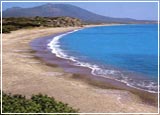 AVLEMONAS BEACH Quiet, sandy beach lying in the settlement of the same name, 26 km. northeast of the island's capital.
AVLEMONAS BEACH Quiet, sandy beach lying in the settlement of the same name, 26 km. northeast of the island's capital.
KAKI LAGADA BEACH Beautiful beach lying near the settlement of Agia Pelagia, 26 km. north of Kythera. According to myth, Venus sat at this point and gazed at the sea.
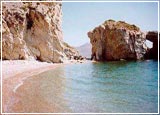 KAPSALAKI BEACH Small sandy beach with small rocks which is situated near Kapsali, 3 km. east of Kythera.
KAPSALAKI BEACH Small sandy beach with small rocks which is situated near Kapsali, 3 km. east of Kythera.
KAPSALI BEACH Beautiful, sandy beach which is situated at the settlement of the same name, 3 km. east of Kythera. In recent years, the area has developed into one of the best resorts on the island.
 PISSO GIALOS BEACH Beach with thin sand and scattered rocks lying in the settlement of the same name, 3 km. from Kythera.
PISSO GIALOS BEACH Beach with thin sand and scattered rocks lying in the settlement of the same name, 3 km. from Kythera.
PLATIA AMOS BEACH Long sandy beach with calm crystal-clear waters beach lying 3.5 km. from the village of Karavas, northwest of Kythera.
All rights reserved 1994-2024.







